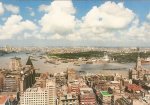- Joined
- Mar 7, 2018
- Messages
- 62,410
- Reaction score
- 19,255
- Location
- Lower Mainland of BC
- Gender
- Male
- Political Leaning
- Centrist
From the BBC
China's staggering 40 years of change in pictures
Forty years ago, China introduced major economic reforms - lifting hundreds of millions of people out of poverty and leading to it becoming the second-largest economy in the world.
Here's the story of how China changed - in pictures.
1. Wheels and more wheels
This is what Chang'an Avenue - a major street in the capital Beijing - looked like in 1978.
COMMENT:-
It's a short read ("big pictures"), so please do so.
What may be of interest is the final graph in the article if you compare it to the graph HERE.
Yes, I know that the odds that the two graphs use the same definition of poverty, but what has to be remembered is that "poverty" is a subjective condition and it "Group A" thinks that it is emerging from poverty (and has some actual evidence that that might be happening) while "Group B" thinks that it is not, then "Group A" is much more likely to be supportive of its own government than "Group B" is - regardless of whether "Group A" and "Group B" are in the same or different countries.
Going from "eating meat" once per month to "eating meat" twice per week IS an improvement - even if those who are "eating meat" twice per day think that it is something that hardly matters.
China's staggering 40 years of change in pictures
Forty years ago, China introduced major economic reforms - lifting hundreds of millions of people out of poverty and leading to it becoming the second-largest economy in the world.
Here's the story of how China changed - in pictures.
1. Wheels and more wheels
This is what Chang'an Avenue - a major street in the capital Beijing - looked like in 1978.
COMMENT:-
It's a short read ("big pictures"), so please do so.
What may be of interest is the final graph in the article if you compare it to the graph HERE.
Yes, I know that the odds that the two graphs use the same definition of poverty, but what has to be remembered is that "poverty" is a subjective condition and it "Group A" thinks that it is emerging from poverty (and has some actual evidence that that might be happening) while "Group B" thinks that it is not, then "Group A" is much more likely to be supportive of its own government than "Group B" is - regardless of whether "Group A" and "Group B" are in the same or different countries.
Going from "eating meat" once per month to "eating meat" twice per week IS an improvement - even if those who are "eating meat" twice per day think that it is something that hardly matters.


